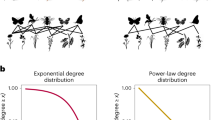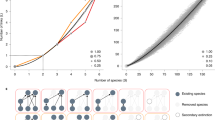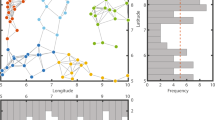Abstract
Larger geographical areas contain more species—an observation raised to a law in ecology. Less explored is whether biodiversity changes are accompanied by a modification of interaction networks. We use data from 32 spatial interaction networks from different ecosystems to analyse how network structure changes with area. We find that basic community structure descriptors (number of species, links and links per species) increase with area following a power law. Yet, the distribution of links per species varies little with area, indicating that the fundamental organization of interactions within networks is conserved. Our null model analyses suggest that the spatial scaling of network structure is determined by factors beyond species richness and the number of links. We demonstrate that biodiversity–area relationships can be extended from species counts to higher levels of network complexity. Therefore, the consequences of anthropogenic habitat destruction may extend from species loss to wider simplification of natural communities.
This is a preview of subscription content, access via your institution
Access options
Access Nature and 54 other Nature Portfolio journals
Get Nature+, our best-value online-access subscription
$29.99 / 30 days
cancel any time
Subscribe to this journal
Receive 12 digital issues and online access to articles
$119.00 per year
only $9.92 per issue
Buy this article
- Purchase on SpringerLink
- Instant access to full article PDF
Prices may be subject to local taxes which are calculated during checkout



Similar content being viewed by others
Data availability
All datasets analysed during the current study are available online at https://doi.org/10.5061/dryad.zcrjdfndg66, https://github.com/nuriagaliana/Ecological-network-complexity-scales-with-area or https://github.com/mlurgi/global-network-area.
Code availability
Custom code used to perform the analyses are available online at https://doi.org/10.5281/zenodo.5758580, https://github.com/nuriagaliana/Ecological-network-complexity-scales-with-area or https://github.com/mlurgi/global-network-area.
References
Arrhenius, O. Species and area. J. Ecol. 9, 95–99 (1921).
MacArthur, R. H. & Wilson, E. O. The Theory of Island Biogeography (Princeton Univ. Press, 1967).
Rosenzweig, M. L. Species Diversity in Space and Time (Cambridge Univ. Press, 1995).
Smith, A. B., Sandel, B., Kraft, N. J. B. & Carey, S. Characterizing scale‐dependent community assembly using the functional‐diversity–area relationship. Ecology 94, 2392–2402 (2013).
Mazel, F. et al. Multifaceted diversity–area relationships reveal global hotspots of mammalian species, trait and lineage diversity. Glob. Ecol. Biogeogr. 23, 836–847 (2014).
Dias, R. A. et al. Species richness and patterns of overdispersion, clustering and randomness shape phylogenetic and functional diversity–area relationships in habitat islands. J. Biogeogr. 47, 1638–1648 (2020).
Pereira, H. M. et al. Scenarios for global biodiversity in the 21st century. Science 330, 1496–1501 (2010).
Pimm, S. L., Russell, G. J., Gittleman, J. L. & Brooks, T. M. The future of biodiversity. Science 269, 347–350 (1995).
Simberloff, D. in Tropical Deforestation and Species Extinction (eds Whitmore, T. C. & Sayer, J. A.) 75–89 (Chapman & Hall, 1992).
Jordano, P. Chasing ecological interactions. PLoS Biol. 14, e1002559 (2016).
Montoya, J. M., Woodward, G., Emmerson, M. C. & Solé, R. V. Press perturbations and indirect effects in real food webs. Ecology 90, 2426–2433 (2009).
Lurgi, M., López, B. C., Montoya, J. M. & Lopez, B. C. Novel communities from climate change. Philos. Trans. R. Soc. Lond. B 367, 2913–2922 (2012).
Tylianakis, J. M., Tscharntke, T. & Lewis, O. T. Habitat modification alters the structure of tropical host–parasitoid food webs. Nature 445, 202–205 (2007).
Montoya, J. M., Rodriguez, M. Á. & Hawkins, B. A. Food web complexity and higher-level ecosystem services. Ecol. Lett. 6, 587–593 (2003).
Reiss, J., Bridle, J. R., Montoya, J. M. & Woodward, G. Emerging horizons in biodiversity and ecosystem functioning research. Trends Ecol. Evol. 24, 505–514 (2009).
Thompson, R. M. et al. Food webs: reconciling the structure and function of biodiversity. Trends Ecol. Evol. 27, 689–697 (2012).
Cohen, J. E. & Newman, C. M. Community area and food-chain length: theoretical predictions. Am. Nat. 138, 1542–1554 (1991).
Schoener, T. W. Food webs from the small to the large: the Robert H. MacArthur Award lecture. Ecology 70, 1559–1589 (1989).
Post, D. M., Pace, M. L. & Hairston, N. G. Ecosystem size determines food-chain length in lakes. Nature 405, 1047–1049 (2000).
Brose, U., Ostling, A., Harrison, K. & Martinez, N. D. Unified spatial scaling of species and their trophic interactions. Nature 428, 167–171 (2004).
Galiana, N. et al. The spatial scaling of species interaction networks. Nat. Ecol. Evol. 2, 782–790 (2018).
Wood, S. A., Russell, R., Hanson, D., Williams, R. J. & Dunne, J. A. Effects of spatial scale of sampling on food web structure. Ecol. Evol. 5, 3769–3782 (2015).
Pimm, S. L. et al. Food web patterns and their consequences. Nature 350, 669–674 (1991).
Martinez, N. D. Constant connectance in community food webs. Am. Nat. 139, 1208–1218 (1992).
Ings, T. C. et al. Ecological networks–beyond food webs. J. Anim. Ecol. 78, 253–69 (2009).
Montoya, J. M. & Solé, R. V. Topological properties of food webs: from real data to community assembly models. Oikos 102, 614–622 (2003).
Drakare, S., Lennon, J. J. & Hillebrand, H. The imprint of the geographical, evolutionary and ecological context on species–area relationships. Ecol. Lett. 9, 215–227 (2006).
Preston, F. W. Time and space and the variation of species. Ecology 41, 611–627 (1960).
Turner, W. R. & Tjørve, E. Scale-dependence in species–area relationships. Ecography 6, 721–730 (2005).
Bengtsson, J. Confounding variables and independent observations in comparative analyses of food webs. Ecology 75, 1282–1288 (1994).
Vermaat, J. E., Dunne, J. A. & Gilbert, A. J. Major dimensions in food-web structure properties. Ecology 90, 278–282 (2009).
Dunne, J. A. et al. Parasites affect food web structure primarily through increased diversity and complexity. PLoS Biol. 11, e1001579 (2013).
Poisot, T. & Gravel, D. When is an ecological network complex? Connectance drives degree distribution and emerging network properties. PeerJ 2, e251 (2014).
Cohen, J. E. & Briand, Fredeiri Trophic links of community food webs. Proc. Natl Acad. Sci. USA 81, 4105–4109 (1984).
Roslin, T., Várkonyi, G., Koponen, M., Vikberg, V. & Nieminen, M. Species–area relationships across four trophic levels—decreasing island size truncates food chains. Ecography 37, 443–453 (2014).
Holt, R. D., Lawton, J. H., Polis, G. A. & Martinez, N. D. Trophic rank and the species–area relationship. Ecology 80, 1495–1504 (1999).
Dunne, J. A., Williams, R. J. & Martinez, N. D. Food-web structure and network theory: the role of connectance and size. Proc. Natl Acad. Sci. USA 99, 12917–12922 (2002).
Montoya, J. M., Pimm, S. L. & Solé, R. V. Ecological networks and their fragility. Nature 442, 259–264 (2006).
James, A., Pitchford, J. W. & Plank, M. J. Disentangling nestedness from models of ecological complexity. Nature 487, 227–230 (2012).
Valverde, S. et al. The architecture of mutualistic networks as an evolutionary spandrel. Nat. Ecol. Evol. 2, 94–99 (2018).
Valiente-Banuet, A. et al. Beyond species loss: the extinction of ecological interactions in a changing world. Funct. Ecol. 29, 299–307 (2015).
Janzen, D. H. The deflowering of central America. Nat. Hist. 83, 49–53 (1974).
Mendoza, M. & Araújo, M. B. Climate shapes mammal community trophic structures and humans simplify them. Nat. Commun. 10, 5197 (2019).
Emer, C. et al. Seed dispersal networks in tropical forest fragments: area effects, remnant species, and interaction diversity. Biotropica 52, 81–89 (2020).
McWilliams, C., Lurgi, M., Montoya, J. M., Sauve, A. & Montoya, D. The stability of multitrophic communities under habitat loss. Nat. Commun. 10, 2322 (2019).
McCann, K. S. The diversity–stability debate. Nature 405, 228–233 (2000).
Fig, T., Mccann, K., Hastings, A. & Huxel, G. R. Weak trophic interactions and the balance of nature. Nature 395, 794–798 (1998).
Pimm, S. L. & Lawton, J. H. Are food webs divided into compartments? J. Anim. Ecol. 49, 879–898 (1980).
Macfadyen, S., Gibson, R. H., Symondson, W. O. C. & Memmott, J. Landscape structure influences modularity patterns in farm food webs: consequences for pest control. Ecol. Appl. 21, 516–524 (2011).
Reverté, S. et al. Spatial variability in a plant–pollinator community across a continuous habitat: high heterogeneity in the face of apparent uniformity. Ecography 42, 1558–1568 (2019).
Torné‐Noguera, A., Arnan, X., Rodrigo, A. & Bosch, J. Spatial variability of hosts, parasitoids and their interactions across a homogeneous landscape. Ecol. Evol. 10, 3696–3705 (2020).
Hernández‐Castellano, C. et al. A new native plant in the neighborhood: effects on plant–pollinator networks, pollination, and plant reproductive success. Ecology 101, e03046 (2020).
Osorio, S., Arnan, X., Bassols, E., Vicens, N. & Bosch, J. Local and landscape effects in a host–parasitoid interaction network along a forest–cropland gradient. Ecol. Appl. 25, 1869–1879 (2015).
Kaartinen, R. & Roslin, T. Shrinking by numbers: landscape context affects the species composition but not the quantitative structure of local food webs. J. Anim. Ecol. 80, 622–631 (2011).
Vázquez, D. P. & Simberloff, D. Changes in interaction biodiversity induced by an introduced ungulate. Ecol. Lett. 6, 1077–1083 (2003).
Mulder, C., Den Hollander, H. A. & Hendriks, A. J. Aboveground herbivory shapes the biomass distribution and flux of soil invertebrates. PLoS ONE 3, e3573 (2008).
Montoya, D., Yallop, M. L. & Memmott, J. Functional group diversity increases with modularity in complex food webs. Nat. Commun. 6, 7379 (2015).
Grass, I., Jauker, B., Steffan-Dewenter, I., Tscharntke, T. & Jauker, F. Past and potential future effects of habitat fragmentation on structure and stability of plant–pollinator and host–parasitoid networks. Nat. Ecol. Evol. https://doi.org/10.1038/s41559-018-0631-2 (2018).
Cagnolo, L., Salvo, A. & Valladares, G. Network topology: patterns and mechanisms in plant–herbivore and host–parasitoid food webs. J. Anim. Ecol. 80, 342–351 (2011).
Maiorano, L., Montemaggiori, A., Ficetola, G. F., O’Connor, L. & Thuiller, W. TETRA‐EU 1.0: a species‐level trophic metaweb of European tetrapods. Glob. Ecol. Biogeogr. 29, 1452–1457 (2020).
Kopelke, J. et al. Food‐web structure of willow‐galling sawflies and their natural enemies across Europe. Ecology 98, 1730 (2017).
Sole, R. V. & Montoya, M. Complexity and fragility in ecological networks. Proc. R. Soc. Lond. B 268, 2039–2045 (2001).
Broido, A. D. & Clauset, A. Scale-free networks are rare. Nat. Commun. 10, 1017 (2019).
Guilhaumon, F., Mouillot, D. & Gimenez, O. mmSAR: an R-package for multimodel species–area relationship inference. Ecography 33, 420–424 (2010).
Matthews, T. J., Triantis, K. A., Whittaker, R. J. & Guilhaumon, F. sars: an R package for fitting, evaluating and comparing species–area relationship models. Ecography https://doi.org/10.1111/ecog.04271 (2019).
Galiana, N. Ecological network complexity scales with area. Dryad https://doi.org/10.5061/dryad.zcrjdfndg (2021).
Acknowledgements
We thank J.-F. Arnoldi, M. Barbier and Y. Zelnik for numerous discussions that improved the quality of this paper. This work was supported by the TULIP Laboratory of Excellence (ANR-10-LABX-41 and 394 ANR-11-IDEX-002-02) to J.M.M., by a Region Midi-Pyrenees project (CNRS 121090) to J.M.M., and by the FRAGCLIM Consolidator Grant (726176) to J.M.M. from the European Research Council under the European Union’s Horizon 2020 Research and Innovation Program. The study was also supported by Spanish MICINN projects CGL2009-12646, CSD2008-0040 and CGL2013-41856 to J.B. and A.R. C.E. was funded through the São Paulo Research Foundation (FAPESP 2015/15172-7). V.A.G.B. was funded by National Funds through FCT—Foundation for Science and Technology under the Project UIDB/05183/2020. W.T. received funding from the ERA-Net BiodivERsA—Belmont Forum, with the national funder Agence National pour la Recherche (FutureWeb: ANR-18-EBI4–0009 and BearConnect: ANR-16-EBI3-0003).
Author information
Authors and Affiliations
Contributions
N.G., J.M.M. and M.L. designed the research with contributions from all co-authors. N.G. and M.L. conducted research and analysed the data. J.B., L.C., B.C.-L., C.E., I.G., C.H.-C., F.J., D.M., C.M., S.O.-C., S.R., A.R., I.S.-D., A.T., D.P.V., S.A.W., T.R. and W.T. contributed the data. J.M.M., V.A.G.B., K.C., M.-J.F., S.J.L., K.M., A.M.M., D.G., T.R., S.V. and W.T. supported research. N.G. and J.M.M. wrote the manuscript with substantial contributions from D.G., T.R. and W.T. and feedback from all co-authors.
Corresponding author
Ethics declarations
Competing interests
The authors declare no competing interests.
Peer review information
Nature Ecology & Evolution thanks Jonathan Chase and the other, anonymous, reviewer(s) for their contribution to the peer review of this work.
Additional information
Publisher’s note Springer Nature remains neutral with regard to jurisdictional claims in published maps and institutional affiliations.
Supplementary information
Supplementary Information
Supplementary Text 1, Tables 1–7 and Figs. 1–8.
Rights and permissions
About this article
Cite this article
Galiana, N., Lurgi, M., Bastazini, V.A.G. et al. Ecological network complexity scales with area. Nat Ecol Evol 6, 307–314 (2022). https://doi.org/10.1038/s41559-021-01644-4
Received:
Accepted:
Published:
Issue Date:
DOI: https://doi.org/10.1038/s41559-021-01644-4



